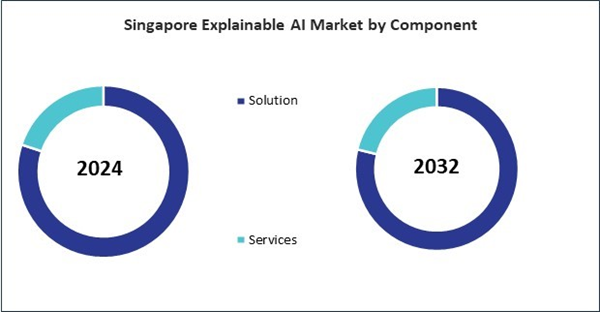The Asia Pacific Explainable AI Market is expected to witness market growth of 21.4% CAGR during the forecast period (2025-2032).
The China market dominated the Asia Pacific Explainable AI Market by country in 2024, and is expected to continue to be a dominant market till 2032; thereby, achieving a market value of $1.60 billion by 2032. The Japan market is registering a CAGR of 20.7% during 2025-2032. Additionally, the India market is expected to showcase a CAGR of 22.2% during 2025-2032.
The manufacturing and industrial automation landscape benefits from XAI through improved predictive maintenance, quality control, and process optimization. AI-driven systems in factories can now explain why certain machinery might be at risk of failure, allowing for targeted interventions that reduce downtime and operational costs. Similarly, in transportation and autonomous vehicles, XAI enhances the safety and adoption of self-driving systems by elucidating the reasons behind real-time navigation decisions and hazard responses.
Other notable applications include retail and e-commerce, where XAI is used to clarify personalized recommendations and dynamic pricing, and the public sector, where it aids in transparent policy-making, resource allocation, and fraud detection. Across all these domains, the ability to provide intelligible, actionable explanations for AI-driven outputs has become a fundamental requirement for adoption.
China stands at the forefront of artificial intelligence adoption in Asia Pacific, and the development of explainable AI (XAI) has become a significant priority as the country advances toward widespread AI-driven digitalization. The government’s proactive policies, outlined in documents like the New Generation Artificial Intelligence Development Plan (AIDP), emphasize the importance of trustworthy and transparent AI. Regulatory bodies, such as the Cyberspace Administration of China (CAC), have issued guidelines for algorithmic accountability and transparency, directly shaping the demand for XAI technologies. Major players, including Huawei, Baidu, Alibaba, and Tencent, have rapidly expanded their AI offerings to include explainable components. These tech giants frequently partner with academic institutions like Tsinghua University and the Chinese Academy of Sciences to enhance the interpretability and reliability of machine learning models.
The China market dominated the Asia Pacific Explainable AI Market by country in 2024, and is expected to continue to be a dominant market till 2032; thereby, achieving a market value of $1.60 billion by 2032. The Japan market is registering a CAGR of 20.7% during 2025-2032. Additionally, the India market is expected to showcase a CAGR of 22.2% during 2025-2032.
The manufacturing and industrial automation landscape benefits from XAI through improved predictive maintenance, quality control, and process optimization. AI-driven systems in factories can now explain why certain machinery might be at risk of failure, allowing for targeted interventions that reduce downtime and operational costs. Similarly, in transportation and autonomous vehicles, XAI enhances the safety and adoption of self-driving systems by elucidating the reasons behind real-time navigation decisions and hazard responses.
Other notable applications include retail and e-commerce, where XAI is used to clarify personalized recommendations and dynamic pricing, and the public sector, where it aids in transparent policy-making, resource allocation, and fraud detection. Across all these domains, the ability to provide intelligible, actionable explanations for AI-driven outputs has become a fundamental requirement for adoption.
China stands at the forefront of artificial intelligence adoption in Asia Pacific, and the development of explainable AI (XAI) has become a significant priority as the country advances toward widespread AI-driven digitalization. The government’s proactive policies, outlined in documents like the New Generation Artificial Intelligence Development Plan (AIDP), emphasize the importance of trustworthy and transparent AI. Regulatory bodies, such as the Cyberspace Administration of China (CAC), have issued guidelines for algorithmic accountability and transparency, directly shaping the demand for XAI technologies. Major players, including Huawei, Baidu, Alibaba, and Tencent, have rapidly expanded their AI offerings to include explainable components. These tech giants frequently partner with academic institutions like Tsinghua University and the Chinese Academy of Sciences to enhance the interpretability and reliability of machine learning models.
List of Key Companies Profiled
- Microsoft Corporation
- IBM Corporation
- Google LLC (Alphabet Inc.)
- Salesforce, Inc.
- Intel Corporation
- NVIDIA Corporation
- SAS Institute Inc.
- Databricks, Inc.
- Amazon Web Services, Inc.
- SAP SE
Market Report Segmentation
By Deployment
- Cloud
- On-premise
By Component
- Solution
- Services
By Application
- Fraud & Anomaly Detection
- Drug Discovery & Diagnostics
- Predictive Maintenance
- Supply Chain Management
- Identity, Access Management & Others
By End-Use
- IT & Telecommunication
- Healthcare
- BFSI
- Aerospace & Defense
- Retail & E-commerce
- Public Sector & Utilities
- Automotive
- Other End-use
By Country
- China
- Japan
- India
- South Korea
- Singapore
- Malaysia
- Rest of Asia Pacific
Table of Contents
Chapter 1. Market Scope & Methodology
Chapter 2. Market at a Glance
Chapter 3. Market Overview
Chapter 4. Competition Analysis - Global
Chapter 5. Value Chain Analysis of Explainable AI Market
Chapter 7. Asia Pacific Explainable AI Market by Deployment
Chapter 8. Asia Pacific Explainable AI Market by Component
Chapter 9. Asia Pacific Explainable AI Market by Application
Chapter 10. Asia Pacific Explainable AI Market by End-use
Chapter 11. Asia Pacific Explainable AI Market by Country
Chapter 12. Company Profiles
Companies Mentioned
- Microsoft Corporation
- IBM Corporation
- Google LLC (Alphabet Inc.)
- Salesforce, Inc.
- Intel Corporation
- NVIDIA Corporation
- SAS Institute Inc.
- Databricks, Inc.
- Amazon Web Services, Inc.
- SAP SE









